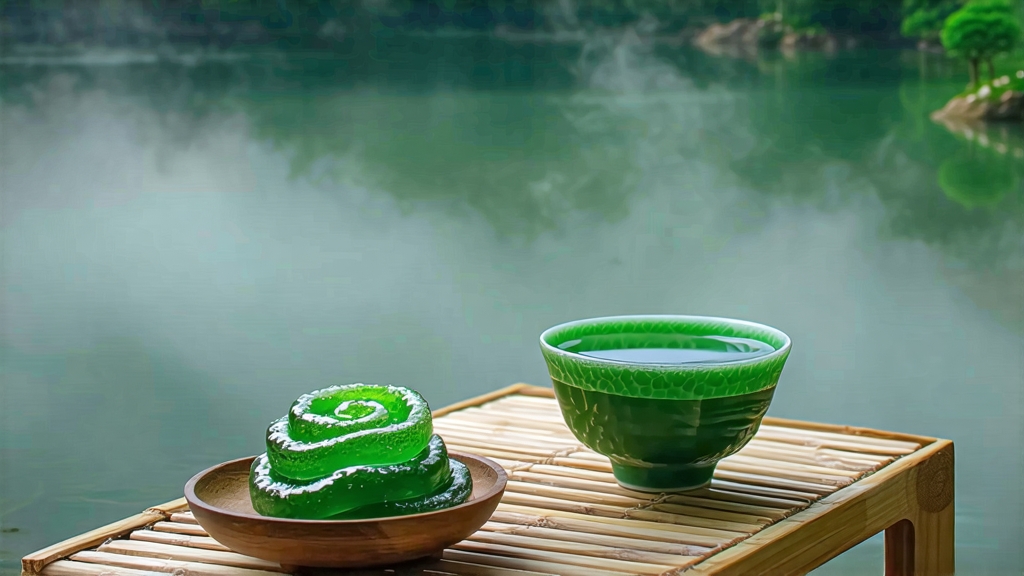
Tucked between the mist-veiled foothills of Dongting Mountain and the gentle ripples of Taihu Lake in Jiangsu Province, Biluochun—literally “Green Snail Spring”—has been celebrated for over a thousand years as one of China’s ten most famous teas. International drinkers often meet it in glossy specialty cafés or tucked inside gift tins, yet few realize how profoundly its identity is shaped by microclimate, folklore, and a curing technique so precise that a single mis-timed hand flick can turn honeyed nectar into bitter straw. This essay invites you to journey from Tang-dynasty poets to modern sustainability labs, learning how tiny spiral buds become liquid jade in a teacup.
Historical whispers
Legend credits a tea-picking nun who wandered the Dongting peaks in the late Tang era. While gathering wild leaves she tucked sprigs into her bodice; body heat lightly oxidized them, releasing an intoxicating perfume that startled passing monks. By the Song dynasty the tea was tribute, carried by barge along the Grand Canal to the northern capital. The Kangxi Emperor (r. 1661-1722), touring the region, thought the original name “Xia Sha Ren Xiang” (literally “scary fragrance”) inelegant and rechristened it Biluochun for its snail-shell curl and spring harvest. European maritime traders first recorded it in 1810 as “Pi-lo-chun—delicate, suitable for ladies,” and today it remains one of the few Chinese greens regularly vacuum-packed for Michelin-starred restaurants from Paris to Melbourne.
Terroir and cultivar nuances
Dongting Mountain is actually two islands—Dongshan (East Mountain) and Xishan (West Mountain)—rising from Taihu, China’s third-largest freshwater lake. The water body moderates temperature, creating nightly fogs that filter sunlight and coax slow, amino-rich growth. Granite soils, rich in potassium and magnesium, drain quickly, stressing bushes just enough to concentrate aromatics. The traditional cultivar is a small-leaf Camellia sinensis var. sinensis locally called “Xiao Ye.” Recent clonal selections such as Dongshan #7 yield earlier yet preserve the signature white-tipped down. Gardens sit interplanted with peach, plum, and loquat; petals fall onto tea rows, adding a subtle floral gene to leaf chemistry. In blind tastings experts can often distinguish island-grown Biluochun from mainland copies by a faint apricot note and a cooler, lake-mineral finish.
Harvest calendar: the race for dawn
Plucking begins around Grain Rain (April 20) when nights stay above 10 °C and buds reach “one flag, one leaf” stature—meaning an unopened tip plus the youngest leaf, no longer than 2.5 cm. Top-grade lots are picked within a ten-day window before 9 a.m., when dew still pearls and polyphenol oxidase activity is low. Crews of experienced women work in pairs, one picking, one cradling a bamboo basket lined with nettle cloth to prevent bruising. Daily yield per picker: barely 500 g fresh leaves, which shrink to 100 g finished tea. The most coveted batch, Mingqian (before Qingming Festival), can fetch over US $2,000 per kilogram at auction.
Crafting the curl: a dance of heat and fingertips
Unlike bulk greens that ride conveyor belts through automated ovens, authentic Biluochun is pan-fired in 64-cm woks tilted over lychee-wood fires. The three-step sequence—shaqing (kill-green), rounian (rolling), and tiemao (curl-setting)—must finish within 40 minutes while leaf temperature hovers between 80 °C and 55 °C.
- Shaqing: 4–5 minutes of high-temperature tossing evaporates grassy volatiles and locks in jade color. Masters listen for the “popcorn crackle” that signals moisture dropping below 58 %.
- Rounian: wok temperature drops to 65 °C; leaves are hand-rubbed in clockwise spirals against the iron wall, breaking cell walls to release sap while forming the iconic tight roll.
- Tiemao: at 50 °C the master repeatedly lifts and drops small handfuls, allowing cool air to penetrate the curl and set the shape. A final 30-second blast at 80 °C halts enzymes and leaves a faint downy “white frost” on the surface—evidence of amino-acid richness.
Throughout, the maker judges